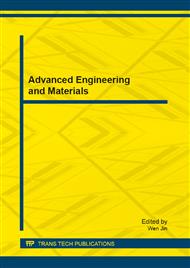[1]
The ESHRE Capri Workshop Group, Intrauterine devices and intrauterine systems, Hum. Reprod. Update 14 (2008) 197-208.
DOI: 10.1093/humupd/dmn003
Google Scholar
[2]
O. Meirik, P. J. Rowe, A. Peregoudov, G. Piaggio, M. Petzold, The frameless copper IUD (GyneFix) and the TCu380A IUD: results of an 8-year multicenter randomized comparative trial, Contraception 80 (2009) 133-141.
DOI: 10.1016/j.contraception.2009.02.006
Google Scholar
[3]
D. Hubacher, V. Reyes, S. Lillo, B. Pierre-Louis, A. Zepeda, P.L. Chen, H. Croxatto, Preventing copper intrauterine device removals due to side effects among first-time users: randomized trial to study the effect of prophylactic ibuprofen, Hum. Reprod. 21 (2006).
DOI: 10.1093/humrep/del029
Google Scholar
[4]
R. Rivera, M. Chen-Mok, S. McMullen, Analysis of client characteristics that may affect early discontinuation of the TCu-380A IUD, Contraception 60 (1999) 155-160.
DOI: 10.1016/s0010-7824(99)00077-3
Google Scholar
[5]
X.P. Xia, S.Z. Cai, C.S. Xie. Preparation, structure and thermal stability of Cu/LDPE nanocomposites, Mater. Chem. Phys. 95 (2006) 122-129.
DOI: 10.1016/j.matchemphys.2005.05.010
Google Scholar
[6]
J.M. Bastidas, N. Mora, E. Cano, Copper corrosion - simulated uterine solutions, Contraception 61 (2000) 395-399.
DOI: 10.1016/s0010-7824(00)00124-4
Google Scholar
[7]
H.F. Liu, Z.L. Liu, C.S. Xie, J. Yu, C.H. Zhu, The antifertility effectiveness of copper/ low-density polyethylene nanocomposite and its influence on the endometrial environment in rats, Contraception 2 (2007) 157-61.
DOI: 10.1016/j.contraception.2006.09.012
Google Scholar
[8]
X.P. Xia, C.S. Xie, C.H. Zhu, S.Z. Cai, X.L. Yang, Effect of implanted Cu/low-density polyethylene nanocomposite on the morphology of endometrium in the mouse, Fertil. Steril. 88 (2007) 472-478.
DOI: 10.1016/j.fertnstert.2006.11.122
Google Scholar
[9]
A.M. Kaunitz, Long-acting contraceptive options, Int. J. Fertil. Meno-pausal Stud. 41 (1996) 69–76.
Google Scholar
[10]
M.J. Beltran-Garcia, A. Espinosa, N. Herrera, A.J. Perez-Zapata, C. Beltran-Garcia, T. Ogura, Formation of copper oxychloride and reactive oxygen species as causes of uterine injury during copper oxidation of Cu-IUD, Contraception 61 (2000).
DOI: 10.1016/s0010-7824(00)00085-8
Google Scholar
[11]
H. Seyednejad, D. Gawlitta, R.V. Kuiper, D.A. Bruin, C.F. F. van Nostrum, T. Vermonden, W.J.A. Dhert, W.E. Hennink, In vivo biocompatibility and biodegradation of 3D-printed porous scaffolds based on a hydroxyl-functionalized poly (ε-caprolactone), Biomaterials 33 (2012).
DOI: 10.1016/j.biomaterials.2012.03.002
Google Scholar
[12]
F. Baino, Biomaterials and implants for orbital floor repair, Acta Biomater. 7 (2011) 3248-3266.
DOI: 10.1016/j.actbio.2011.05.016
Google Scholar
[13]
S. Krenzlin, C. Vincent, L. Munzke, D. Gnansia, J. Siepmann, F. Siepmann, Predictability of drug release from cochlear implants, J. Controlled Release 159 (2012) 60-68.
DOI: 10.1016/j.jconrel.2011.12.032
Google Scholar
[14]
E. Jämstorp, J. Forsgren, S. Bredenberg, H. Engqvist, M. Strømme, Bioceramics for slow release of drugs, J. Controlled Release 146 (2010) 370-377.
DOI: 10.1016/j.jconrel.2010.05.029
Google Scholar
[15]
C. Qi, X.P. Xia, W.W. Zhang, C.S. Xie, S.Z. Cai, Indomethacin/Cu/LDPE porous composite for medicated copper intrauterine devices with controlled release performances, Compos. Sci. Technol. 72 (2012) 428-434.
DOI: 10.1016/j.compscitech.2011.12.004
Google Scholar
[16]
W.W. Zhang, X.P. Xia, C. Qi, C.S. Xie, S.Z. Cai, A porous Cu/LDPE composite for copper-containing intrauterine contraceptive devices, Acta Biomater. 8(2012) 897-903.
DOI: 10.1016/j.actbio.2011.09.024
Google Scholar
[17]
N. Sudarmadji, J.Y. Tan, K.F. Leong, C.K. Chua, Y.T. Loh, Investigation of the mechanical properties and porosity relationships in selective, Acta Biomater. 7 (2011) 530-537.
DOI: 10.1016/j.actbio.2010.09.024
Google Scholar
[18]
A. Bandyopadhyay, F. Espana, V.K. Balla, S. Bose, Y. Ohgami, N.M. Davies, Influence of porosity on mechanical properties and in vivo response of Ti6Al4V implants, Acta Biomater. 6 (2010) 1640-1648.
DOI: 10.1016/j.actbio.2009.11.011
Google Scholar
[19]
R.W. Rice, Use of normalized porosity in models for the porosity dependence of mechanical properties, J. Mater. Sci. 40 (2005) 983-989.
DOI: 10.1007/s10853-005-6517-0
Google Scholar
[20]
Y. Tang, X.P. Xia, Y. Wang, C.S. Xie, Study on the mechanical properties of Cu/LDPE composite IUDs, Contraception 83 (2011) 255-262.
DOI: 10.1016/j.contraception.2010.07.015
Google Scholar
[21]
D. Olmos, C. Domínguez, P.D. Castrillo, J. Gonzalez-Benito, Crystallization and final morphology of HDPE: Effect of the high energy ball milling and the presence of TiO2 nanoparticles, Polymer 50 (2009) 1732-1742.
DOI: 10.1016/j.polymer.2009.02.011
Google Scholar


